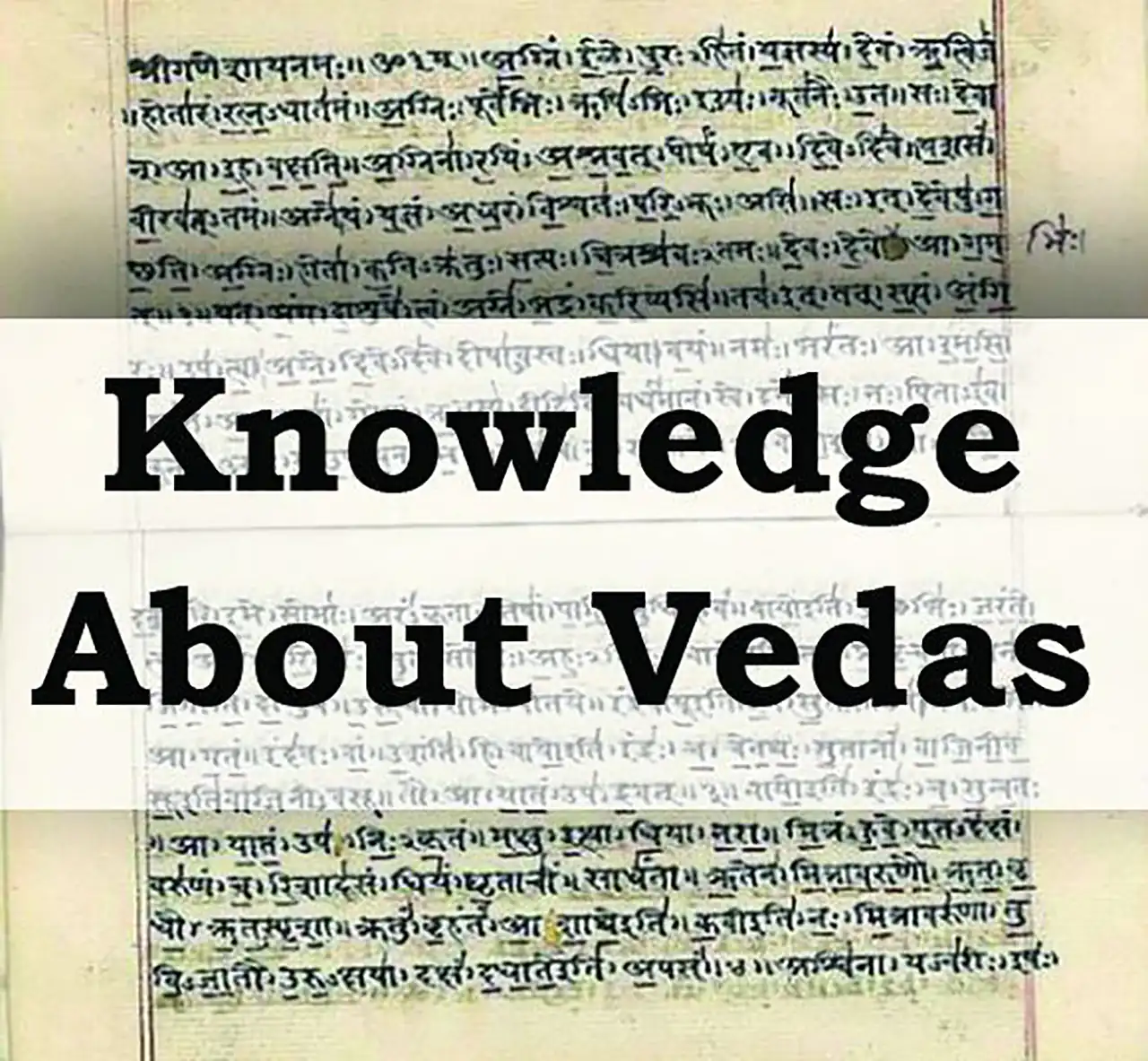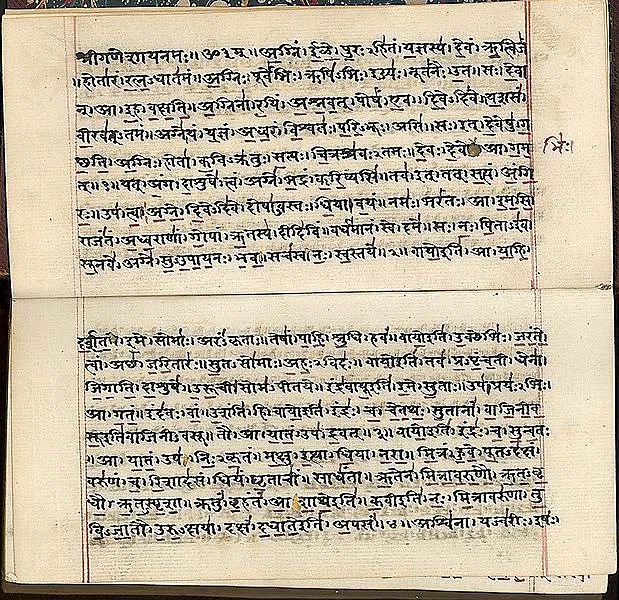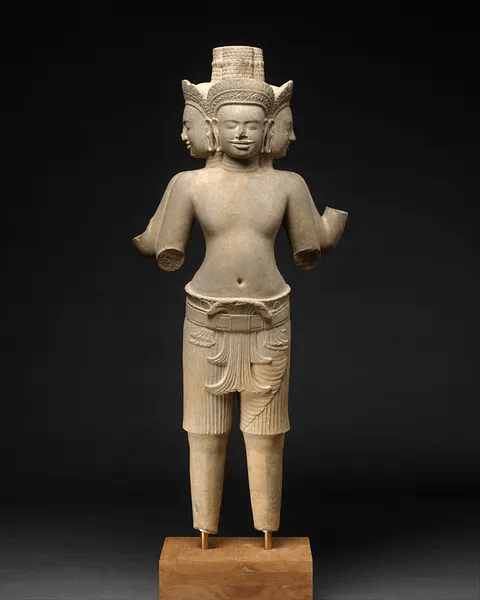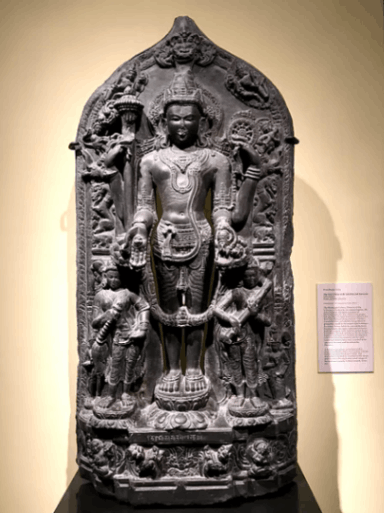Knowledge about Vedas

Knowledge about Vedas
The holy writings known as the Vedas serve as the foundation for Hinduism, sometimes referred to as Sanatan Dharma, which means "Eternal Order" or "Eternal Path." In the sense that they are believed to contain the fundamental knowledge relating to the underlying source of, function of, and individual response to existence, the name "veda" means "knowledge." The Rigveda, Yajurveda, Samaveda, and Atharvaveda are the four divisions of the Vedas.
They are regarded as one of the world's oldest, if not the oldest, religious works. Since they might be characterised as holy writings describing the nature of the Divine, they are frequently referred to as "scripture," which is true. The Vedas, however, are not thought to have been revealed to a particular person or people at a particular historical moment, unlike the scriptures of other religions; rather, it is believed that they have always existed and were discovered by sages during deep meditation at some unknown time before 1500 BCE.
In India, between approximately 1500 and 500 BCE (the so-called Vedic Period), the Vedas were written down after many generations of oral transmission from teacher to pupil. In order to maintain the integrity of what was initially heard, masters would make students learn them both forward and backward, with a focus on correct pronunciation.
They are regarded as one of the world's oldest, if not the oldest, religious works. Since they might be characterised as holy writings describing the nature of the Divine, they are frequently referred to as "scripture," which is true. The Vedas, however, are not thought to have been revealed to a particular person or people at a particular historical moment, unlike the scriptures of other religions; rather, it is believed that they have always existed and were discovered by sages during deep meditation at some unknown time before 1500 BCE.
In India, between approximately 1500 and 500 BCE (the so-called Vedic Period), the Vedas were written down after many generations of oral transmission from teacher to pupil. In order to maintain the integrity of what was initially heard, masters would make students learn them both forward and backward, with a focus on correct pronunciation.

Hinduism views the Vedas as Shruti, or "what is heard," in contrast to other books called Smritis, or "what is remembered," which provide descriptions of famous heroes and their battles in works like the Mahabharata, Ramayana, and Bhagavad Gita (although some sects of Hinduism regard the Bhagavad Gita as Shruti). The Four Vedas are composed of the following texts:
- Rig Veda
- Sama Veda
- Yajur Veda
- Atharva Veda
Each of them is further separated into the many sorts of text that each one contains:
- Aranyakas - rituals, observances
- Brahmanas - commentaries on said rituals
- Samhitas - benedictions, prayers, mantras
- Upanishads – philosophical narratives and dialogues
Since the Upanishads were the first Vedic texts to be translated into foreign languages and because they provide their discourse in conversation and narrative form, they are the most well-known and frequently read of the Vedic texts. The four Vedas, on the other hand, are thought to be the exact sounds of the Divine that, when spoken or sung, imitate the universe's first vibrations. In light of this, it is actually impossible to translate them, hence everything that is read in a translation should only be taken as a paraphrase.
Although not all Hindu sects do so, orthodox Hindu denominations see the Vedas as a key source of spiritual guidance. As a result, certain sects or offshoots of Hinduism (like the Brahmos Movement) completely reject the Vedas as superstition. Reform movements throughout the modern age, starting in the 19th century CE, place a greater weight on personal religious experience than scriptural authority and tradition. Even yet, the writings are still read, studied, and revered today and are still a significant element of Hindu religious rituals, festivals, and festivities.
Early Origin, Dating, & Development
Although numerous academics and theologians have made varying assertions regarding the Vedas' origins, no one is certain of its veracity. Though not widely recognised, it is generally considered that nomadic Aryan tribes who moved to India from Central Asia around the third millennium BCE brought with them the Vedic vision. As used by the populace of the time, "Aryan" should be understood to signify "free" or "noble," a class of people rather than a race, and not Caucasian (as was claimed by 18th- and 19th-century CE Western scholars). It is believed that these Indo-Aryans were part of a larger group that also included the Indo-Iranians, who settled in the area of present-day Iran and became known in the Persians in the West (via the Greeks). The similarities between early Hinduism and early Iranian religion (and subsequently Zoroastrianism) point to a shared belief system that eventually developed independently.
According to the Indo-Aryan Migration Theory, the Vedic vision was created in Central Asia and transported to India during the decline of the native Harappan Civilization (c. 7000–600 BCE) during c. 2000–1500 BCE, fusing that culture's ideas with their own. However, according to the Out of India (OIT) theory, the Harappan Civilization already possessed this vision and had exported it from India to Central Asia, where it was then brought back by the migration of the Indo-Aryans.
Scholars seem to subscribe to one or the other more for personal reasons than any based on objective, academic study, however there are good reasons to recognise the motivation, at least, for either claim (albeit the OIT is rejected by mainstream academia). The truth that one does not know is the most logical answer to the subject of the Vedas' origin and chronology. But the dispute continues today because humans have a natural desire to understand the unexplained. Hermann Kulke and Dietmar Rothermund, two academics, make the following quick observations on the early genesis of the dating/origin issue:
Indologists have long contested the chronology of these texts and the societies who created them. Bal Gangadhar Tilak, a great Indian nationalist, authored a book titled The Arctic Home of the Vedas in which he claimed that the Vedas could be traced back to the sixth or fifth millennia BCE. He based his results on the interpretation of references to star locations in the text that astronomers might use to calculate the relevant date in detail. Hermann Jacobi, a German Indologist, came to a very similar result and proposed the middle of the fifth millennium as the period of the Vedas. However, another German Indologist, Max Muller, who was teaching at Oxford at the time, forecasted a far later date. He began with Buddha's birth about 500 BCE and proposed that the Upanishads, which predate Buddhist doctrine, were written between 800 and 600 BCE. The older Brahmana and Mantra texts of the Vedas would have been composed between 1000 and 800, and 1200 and 1000, respectively. Max Muller's anticipated dates correspond quite well with recent archaeological research, which shows at least a millennium between the demise of the Indus Civilization and the arrival of a new nomadic people, possibly the Vedic Indo-Aryans.
Muller's study continues to impact the argument today, and his claims are often regarded as the most likely, though not certain. Wherever the Vedic vision started, and whatever long it existed in oral form, it evolved in India after the arrival of the Indo-Aryans during the Vedic Period.
Early Origin, Dating, & Development
Although numerous academics and theologians have made varying assertions regarding the Vedas' origins, no one is certain of its veracity. Though not widely recognised, it is generally considered that nomadic Aryan tribes who moved to India from Central Asia around the third millennium BCE brought with them the Vedic vision. As used by the populace of the time, "Aryan" should be understood to signify "free" or "noble," a class of people rather than a race, and not Caucasian (as was claimed by 18th- and 19th-century CE Western scholars). It is believed that these Indo-Aryans were part of a larger group that also included the Indo-Iranians, who settled in the area of present-day Iran and became known in the Persians in the West (via the Greeks). The similarities between early Hinduism and early Iranian religion (and subsequently Zoroastrianism) point to a shared belief system that eventually developed independently.
According to the Indo-Aryan Migration Theory, the Vedic vision was created in Central Asia and transported to India during the decline of the native Harappan Civilization (c. 7000–600 BCE) during c. 2000–1500 BCE, fusing that culture's ideas with their own. However, according to the Out of India (OIT) theory, the Harappan Civilization already possessed this vision and had exported it from India to Central Asia, where it was then brought back by the migration of the Indo-Aryans.
Scholars seem to subscribe to one or the other more for personal reasons than any based on objective, academic study, however there are good reasons to recognise the motivation, at least, for either claim (albeit the OIT is rejected by mainstream academia). The truth that one does not know is the most logical answer to the subject of the Vedas' origin and chronology. But the dispute continues today because humans have a natural desire to understand the unexplained. Hermann Kulke and Dietmar Rothermund, two academics, make the following quick observations on the early genesis of the dating/origin issue:
Indologists have long contested the chronology of these texts and the societies who created them. Bal Gangadhar Tilak, a great Indian nationalist, authored a book titled The Arctic Home of the Vedas in which he claimed that the Vedas could be traced back to the sixth or fifth millennia BCE. He based his results on the interpretation of references to star locations in the text that astronomers might use to calculate the relevant date in detail. Hermann Jacobi, a German Indologist, came to a very similar result and proposed the middle of the fifth millennium as the period of the Vedas. However, another German Indologist, Max Muller, who was teaching at Oxford at the time, forecasted a far later date. He began with Buddha's birth about 500 BCE and proposed that the Upanishads, which predate Buddhist doctrine, were written between 800 and 600 BCE. The older Brahmana and Mantra texts of the Vedas would have been composed between 1000 and 800, and 1200 and 1000, respectively. Max Muller's anticipated dates correspond quite well with recent archaeological research, which shows at least a millennium between the demise of the Indus Civilization and the arrival of a new nomadic people, possibly the Vedic Indo-Aryans.
Muller's study continues to impact the argument today, and his claims are often regarded as the most likely, though not certain. Wherever the Vedic vision started, and whatever long it existed in oral form, it evolved in India after the arrival of the Indo-Aryans during the Vedic Period.
The Vedic Period
The Vedic Period (c. 1500 - c. 500 BCE) is when the Vedas were written down, however this has nothing to do with the antiquity of the concepts or the oral traditions themselves. The term "Vedic Period" is a contemporary invention based on evidence of an Indo-Aryan migration, which, as previously said, is not widely acknowledged. Nonetheless, based on the data, that is the theory most frequently acknowledged as historically true. Scholar John M. Koller describes the evolution of the texts:
Between 2000 and 1500 BCE, the Sanskrit-speaking peoples started to dominate life and thinking in the Indus Valley, ushering in the Vedic period. Historians used to believe that these Sanskrit-speaking peoples known as Aryans conquered the Indus valley in northwest India around thirty-five hundred years ago. Recent study, however, has called this theory of conquering Aryans into question. What we do know is that the older Indus civilisation, which thrived from 2500 to 1500 BCE and was extremely complex based on archaeological artefacts, fell about this period. We also know that the Vedic ideas and culture portrayed in the Rig Veda had a long history of supremacy in India over the last three and a half centuries. The cultural traditions of the Vedic peoples are thought to have blended with the traditions and practises of the Indus people.
The religious beliefs of the Harappans are unclear since they left no written texts. Excavations at Mohenjo-daro, Harappa, and other sites indicate a highly developed belief system that included ceremonial bathing and some type of worship ceremony. The only unambiguous evidence of religious belief and activity comes from yaksha sculpture, which dates to from 3000 BCE in primitive form and continues, with more sophistication, into the 1st century BCE.

Obed Suhail (CC BY-SA)
The Yaksha Cults appear to have concentrated on everyday needs (assuming the evidence is interpreted similarly to ancestor cults), as the spirits might be helpful or malicious, and sacrifices were performed either for blessings requested or to fend off harm. There was little focus on the "grand picture" of where humans originated from, what their function could be, or where they went after death, as in Asian ancestor cults. These are the concerns answered by the Rig Veda (meaning "Knowledge of Wisdom," "Verses of Wisdom," or, literally, "Praise Knowledge"), which informs the other three Vedas.
The Vedas
As previously stated, followers of Sanatan Dharma (Hinduism) believe the Vedas have always existed. Forrest E. Baird and Raeburne S. Heimbeck, academics, note:
The Vedas are the only holy scriptures in Hinduism that have a supernatural origin. These four books solely are considered to disclose the vital wisdom of life. Hindus believe that such knowledge has existed forever in the form of vibrations heard across the cosmos. These mysterious vibrations went unnoticed until select Indian sages with spiritual hearing heard and codified them in the Sanskrit language around 3,200 years ago.
The Vedas are considered to repeat the precise sounds of the cosmos itself at the time of creation and thereafter, and hence take the form of hymns and chants. Reciting the Vedas is regarded to be partaking in the universe's creative song, which gave birth to all things observable and unobservable from the beginning of time. The Rig Veda establishes the norm and tone for the Sama Veda and Yajur Veda, whereas the Atharva Veda develops its own vision that is inspired by the earlier works but pursues its own unique path.

Brahma, Cambodian Statue
Metropolitan Museum of Art (Copyright)
The Vedas
As previously stated, followers of Sanatan Dharma (Hinduism) believe the Vedas have always existed. Forrest E. Baird and Raeburne S. Heimbeck, academics, note:
The Vedas are the only holy scriptures in Hinduism that have a supernatural origin. These four books solely are considered to disclose the vital wisdom of life. Hindus believe that such knowledge has existed forever in the form of vibrations heard across the cosmos. These mysterious vibrations went unnoticed until select Indian sages with spiritual hearing heard and codified them in the Sanskrit language around 3,200 years ago.
The Vedas are considered to repeat the precise sounds of the cosmos itself at the time of creation and thereafter, and hence take the form of hymns and chants. Reciting the Vedas is regarded to be partaking in the universe's creative song, which gave birth to all things observable and unobservable from the beginning of time. The Rig Veda establishes the norm and tone for the Sama Veda and Yajur Veda, whereas the Atharva Veda develops its own vision that is inspired by the earlier works but pursues its own unique path.

Brahma, Cambodian Statue
Metropolitan Museum of Art (Copyright)
Rig Veda: The Rig Veda is the oldest of the writings, consisting of ten books (called mandalas) containing 1,028 hymns and 10,600 lines. These words address fundamental concerns about life as well as correct religious attendance and practise, based on universal vibrations as perceived by the sages who originally heard them. Koller's thoughts:
Vedic intellectuals pondered their own selves, the world around them, and their position in it. What is being thought? What is the source of it? What causes the wind to blow? Who placed the sun, the source of warmth and light, in the sky? How does the planet produce such a diverse range of life-forms? How do we re-create ourselves and become whole? Philosophical contemplation begins with questions of how, what, and why.
This philosophical insight captures the core of Hinduism in that the purpose of personal existence is to examine it as one progresses from fundamental necessities to self-actualization and oneness with the Divine. The Rig Veda fosters such inquiries through hymns to numerous gods, most notably Agni, Mitra, Varuna, Indra, and Soma, who would later be viewed as avatars of Brahman, the Supreme Over Soul, First Cause, and Source of Existence. Some Hindu schools of thought believe that the Vedas were created by Brahman, whose song the sages then heard.
Sama Veda: The Sama Veda ("Melody Knowledge" or "Song Knowledge") is a collection of sung liturgical hymns, chants, and texts. The material is nearly entirely borrowed from the Rig Veda, and some academics have noticed that the Rig Veda acts as the lyrics to the Sama Veda's melodies. It has 1,549 verses and is separated into two sections: gana (melodies) and arcika (verses). The melodies are supposed to inspire dance, which, when paired with the lyrics, lifts the soul.
Yajur Veda: The Yajur Veda ("Worship Knowledge" or "Ceremonial Knowledge") is a collection of recitations, ritual worship formulae, mantras, and chants used in worship ceremonies. Its substance, like the Sama Veda, is derived from the Rig Veda, but the concentration of its 1,875 lines is on religious observance ritual. It is commonly thought to have two "components" that are not independent portions but rather aspects of the total. The "dark Yajur Veda" refers to passages that are confusing and badly organised, whereas the "bright Yajur Veda" refers to verses that are clearer and more organised.
"The Yajur Veda consists of recitations, ritual worship formulas, mantras, & chants directly involved in worship services."
Atharva Veda: The Atharva Veda ("knowledge of Atharvan") is distinguished from the other three by its emphasis on magical spells to fend off bad spirits or danger, chants, hymns, prayers, initiation rites, marriage and burial ceremonies, and observations on daily life. The name is said to be derived from the priest Atharvan, who was reputed to be a healer and religious innovator. It is assumed that the book was written at the same time as the Sama Veda and Yajur Veda by one individual (perhaps Atharvan, but this is unlikely) or individuals (c. 1200-1000 BCE). It consists of 20 books including 730 hymns, some of which are based on the Rig Veda. Some theologians and scholars have rejected it as a legitimate Veda due to the nature of the work, the language utilised, and the shape it takes. It is currently accepted by some but not all Hindu sects since it deals with later knowledge that is recalled rather than foundational wisdom that was heard.
The other sorts of writings indicated above - the Aranyakas, Brahmanas, Samhitas, and Upanishads - are embedded in each of these works and may be regarded glosses, expansions, or commentaries on the main text.
The Upanishads are regarded as the "end of the Vedas," as the final word on the scriptures. The phrase Upanishads refers to "sitting closely" with a teacher in order to learn knowledge not meant for the rest of the class. Each of the Vedas' Upanishads comment on or illustrate the text through conversation and storey, explaining difficult or confusing parts or concepts.

Conclusion
The Vedas, particularly the Upanishads, would eventually constitute the core philosophy of Sanatan Dharma, giving believers direction and purpose in their lives. It was discovered that there was a single entity, Brahman, who not only created but was also existence itself. Because this entity was too enormous for humans to fathom, he manifested as avatars such as Brahma (the creator), Vishnu (the preserver), and Shiva (the destroyer), as well as a slew of other deities, all of whom were truly Brahman. The purpose of a human life was to recognise one's higher self (the Atman) and perform the dharma (duty) that had been assigned to one with the appropriate karma (action) in order to free oneself from the cycle of rebirth and death (samsara) that was characterised by the suffering and loss one experienced in the physical world. After breaking these connections, an individual's Atman returned to Brahman and eternal tranquilly.
This belief system evolved continuously until the establishment of Islam in northern India beginning in the 7th century CE, which became pronounced by the 12th century CE. Only gradually did Islamic control come to accept Hindu traditions. Later, in the 18th and 20th centuries CE, British colonialism and imperialism posed a considerably more serious challenge to the Vedic worldview. The British attempted to convert the Indian people to Protestant Christianity, re-educating the public, and rejecting Hinduism as a wicked superstition.
The Vedas, particularly the Upanishads, would eventually constitute the core philosophy of Sanatan Dharma, giving believers direction and purpose in their lives. It was discovered that there was a single entity, Brahman, who not only created but was also existence itself. Because this entity was too enormous for humans to fathom, he manifested as avatars such as Brahma (the creator), Vishnu (the preserver), and Shiva (the destroyer), as well as a slew of other deities, all of whom were truly Brahman. The purpose of a human life was to recognise one's higher self (the Atman) and perform the dharma (duty) that had been assigned to one with the appropriate karma (action) in order to free oneself from the cycle of rebirth and death (samsara) that was characterised by the suffering and loss one experienced in the physical world. After breaking these connections, an individual's Atman returned to Brahman and eternal tranquilly.
This belief system evolved continuously until the establishment of Islam in northern India beginning in the 7th century CE, which became pronounced by the 12th century CE. Only gradually did Islamic control come to accept Hindu traditions. Later, in the 18th and 20th centuries CE, British colonialism and imperialism posed a considerably more serious challenge to the Vedic worldview. The British attempted to convert the Indian people to Protestant Christianity, re-educating the public, and rejecting Hinduism as a wicked superstition.
This eventually resulted in the Brahmos Movement, led by Ram Mohan Roy (l. 1772-1833 CE) and continued by others such as Debendranath Tagore (1817-1905 CE, father of poet Rabindranath Tagore), who responded in part by reimagining their faith to distance it from the traditional form, which appeared to have been corrupted by outside influences. This reinterpretation included a denial of canonical authority, and the Vedas' status fell. In reality, the Brahmos Movement rejected the Vedas totally as superstitious folly and instead centred on a personal encounter with the Divine, which was fairly similar to the theological orientation of both Protestant Christianity and the older Hindu Bhakti Movement of the Middle Ages.
Any Hindu group or organisation that opposes the Vedas today derives its basic platform from 19th- and early 20th-century CE initiatives such as Brahmos. However, Orthodox Hindus still hold the Vedas in high respect, and the works are still chanted and sung by those who realise in them the mystery of an inexpressible truth presented without simple explanation, which may be experienced without having to be comprehended.
Any Hindu group or organisation that opposes the Vedas today derives its basic platform from 19th- and early 20th-century CE initiatives such as Brahmos. However, Orthodox Hindus still hold the Vedas in high respect, and the works are still chanted and sung by those who realise in them the mystery of an inexpressible truth presented without simple explanation, which may be experienced without having to be comprehended.